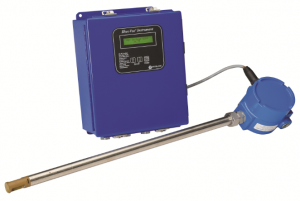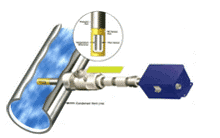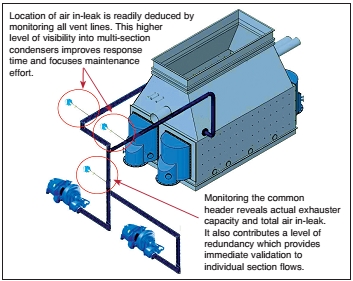

RheoVac Air In-Leak Monitor
 It is generally known that excessive turbine back pressure is easily determined so that corrective actions can be taken promptly. However, small amounts of excess back pressure often go unnoticed and can cost millions of dollars over the long haul. RheoVac instruments continuously monitor air in-leakage, exhauster capacity and other parameters to give you the information needed to identify small deficiencies and diagnose operating problems. This allows you to keep the condenser system operating at its highest performance level. Case Studies
It is generally known that excessive turbine back pressure is easily determined so that corrective actions can be taken promptly. However, small amounts of excess back pressure often go unnoticed and can cost millions of dollars over the long haul. RheoVac instruments continuously monitor air in-leakage, exhauster capacity and other parameters to give you the information needed to identify small deficiencies and diagnose operating problems. This allows you to keep the condenser system operating at its highest performance level. Case Studies
What Are the Benefits?
Air in-leakage can affect back pressure, DO, and corrosion, which in turn can have significant short-term and long-term cost effects on the entire generating unit. To learn more about the impact of air in-leak on condenser performance, and how Bionetics can help you quantify and locate the leaks in your condenser, visit Condenser Pressure and Air In-Leakage. The RheoVac Air In-Leak Monitor is a unique multi-sensor instrument which provides real-time data to monitor the performance of your condenser which, if properly addressed, can affect all three of these problems.
RheoVac instruments help you to:
- Quantify and locate air in-leak
- Detect tube fouling
- Reduce heat rate
- Decrease corrosion
- Identify lost load
- Minimize excess fuel usage
- Increase availability
- Improve water chemistry
RheoVac Customer Comments and Experiences
How Do They Work?
RheoVac monitors use unique multi-sensor probes to measure or compute various parameters in the condenser exhaust line. The four primary sensors measure flow, temperature, pressure and relative saturation. An electronics unit, connected to either one or more probes, displays the parameters locally, and provides an output, typically Ethernet, to bring all the data to the plant data acquisition system.
What Are the Key Data Outputs?
- Air in-leakage: continuously monitoring air in-leakage allows action to be taken before its rising value can affect back pressure. There is immediate feedback on efforts to reduce the air in-leak, and changes in air in-leakage can be correlated to other plant events. This is extremely useful in troubleshooting.
- Total mass flow and actual volumetric flow: these show the actual operating effectiveness of the vacuum equipment to remove air, other noncondensables and water vapor in comparison with the vacuum equipment’s performance curves. With this information you know if the pump (or ejector) is working properly.
- Water vapor-to-air mass ratio: this is a direct measurement of vacuum quality. Water vapor-to-air mass ratio precisely identifies the point at which excess back pressure will occur. Once excess back pressure is known to exist, turning on an additional exhauster, or repairing air in-leaks, will reduce back pressure and save you money.

How Are They Installed?
The multi-sensor probes are installed, through supplied isolation ball valves, into the condenser vacuum pipes, between the condenser and the pumps or ejectors. Depending on generating unit size and pipe layout, one or more probes are used as shown in the drawing. The electronics unit can be located on the plant floor or remotely in the control room.
RheoVac systems are available for purchase or rent from Bionetics. Renting allows you to get the RheoVac Air In-Leak Monitor you need for the exact amount of time you need it, providing savings over purchasing a system to prove its value. Click here for more information on renting vs. purchasing a RheoVac system, or you can use the form on this page to request a quote. If you have any questions or need additional information, you can also reach us using the information on our Contact Us page.
- Provides direct reading of condenser air in-leak
- Measures actual exhauster capacity
- Quantifies excess back pressure
- On-line insertion through leak-tight ball valve assembly
- On-board sensor diagnostics
- Real time data is stored locally and can be routed to DCS
- Displays air in-leakage, water vapor to air mass ratio, total mass flow, temperature, pressure, relative saturation, and actual volumetric flow rate
| Temperature | Probe: 40° – 210 °F; Up to 400 °F optional Electronics: 40° – 120 °F |
| Pressure | 0.5 – 10” HgA |
| Calibration Accuracy | ± 5% of total mass flow |
| Repeatability | ± 1.5% of reading |
| Line Sizes | 3” through 18” |
| Process Connection | 1.5” ball valve assembly |
| Wetted Material | 316 Stainless steel probe; Engineered plastic probe tip (stainless steel optional for high temp) |
| Display | Backlit LCD |
| Enclosure | NEMA 4 |
| Outputs | Local display, Ethernet, RS-422/232, OPC, Modbus, and 4-20mA (optional) |
| Input Power | 100 – 250 VAC; 50 – 60 Hz |
|
|||||
|
|
||||
|
|
||||
|
|



